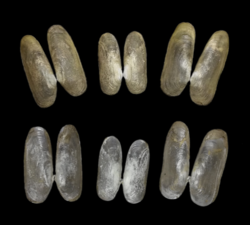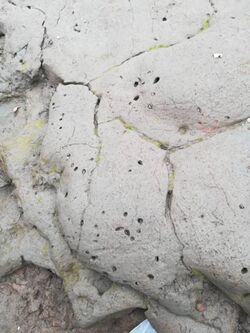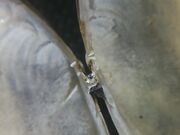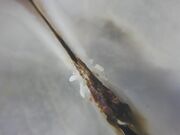Biology:Novaculina chinensis
| Novaculina chinensis | |
|---|---|

| |
| Scientific classification | |
| Domain: | Eukaryota |
| Kingdom: | Animalia |
| Phylum: | Mollusca |
| Class: | Bivalvia |
| Order: | Adapedonta |
| Family: | Pharidae |
| Genus: | Novaculina |
| Species: | N. chinensis
|
| Binomial name | |
| Novaculina chinensis Liu & Zhang, 1979
| |
Novaculina chinensis is a species of fresh water razor clam in the family Pharidae.[1]
Morphology
The species' shell is oblong, small, equivalve, inequilateral, with anterior end rounded, posterior end truncated. It is about three times as long as high. The surface is wrinkled with growth lines and the epidermis is yellowish-green, folding over in the edge and extremities of the shell.
The interior of shell is non-nacreous and whitish. The anterior adductor muscle scar narrow, elongate-triangular; the posterior adductor muscle scar is wide and broadly triangular.[2]
Distribution and habitat
This species lives in the mud under fresh water.[citation needed] It occurs only in China , with a wide range north to Shandong Province and south to Guangdong Province. The type locality is Jiangsu Province, Wuxi, Tai Lake and Gaoyou Lake.[2] It has also been recorded from Fujian Province, Fuzhou, Minhou County, Shangan Town, Tao River;[3] Shandong Province, Weishan Lake;[4] Hubei Province, Wuhan, estuary of Han River; and Guangdong Province, Shenzhen River.[citation needed]
Comparison
Novaculina chinensis is similar to Sinonovacula constricta, which is also a mud-dwelling razor clam. These two species both have oblong, end-truncated, yellowish-green and fragile shells, but they are still easy to be distinguished. Firstly, Novaculina chinensis lives in pure fresh water and Sinonovacula constricta lives in intertidal zone. The Novaculina chinensis is apparently smaller than Sinonovacula constricta , while their wrinkles of periostracum and teeth of hinkles are also different.[citation needed]
References
- ↑ "WoRMS - World Register of Marine Species - Novaculina chinensis Liu & Zhang, 1979" (in en). http://www.marinespecies.org/aphia.php?p=taxdetails&id=536680.
- ↑ 2.0 2.1 "我国江苏省淡水蛏类一新种——中国淡水蛏--《动物分类学报》1979年04期". http://www.cnki.com.cn/Article/CJFD1979-DWFL197904010.htm.
- ↑ "福建省闽侯县陶江中国淡水蛏栖息环境和生物学研究--《动物学杂志》1998年06期". http://www.cnki.com.cn/Article/CJFDTotal-BIRD806.000.htm.
- ↑ 舒凤月; 朱庆超; 张念伟; 张希金; 谢松光 (2013). 微山湖发现中国淡水蛏. http://ir.ihb.ac.cn/handle/342005/19688.
Wikidata ☰ Q13905103 entry
 |





